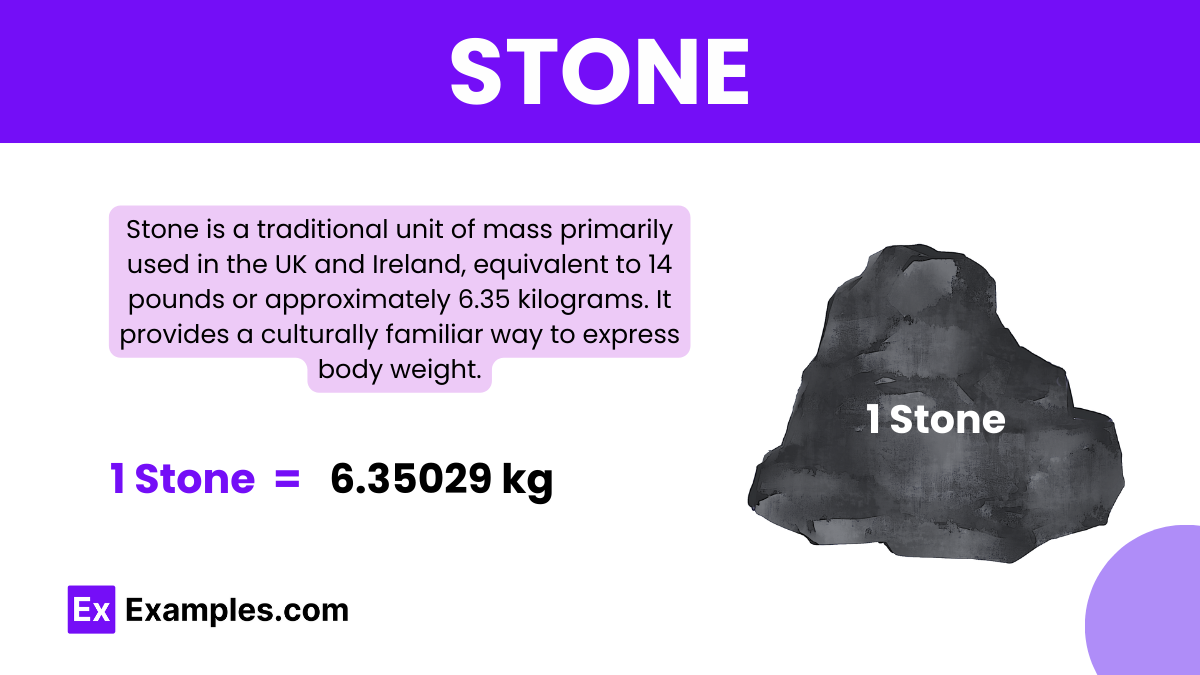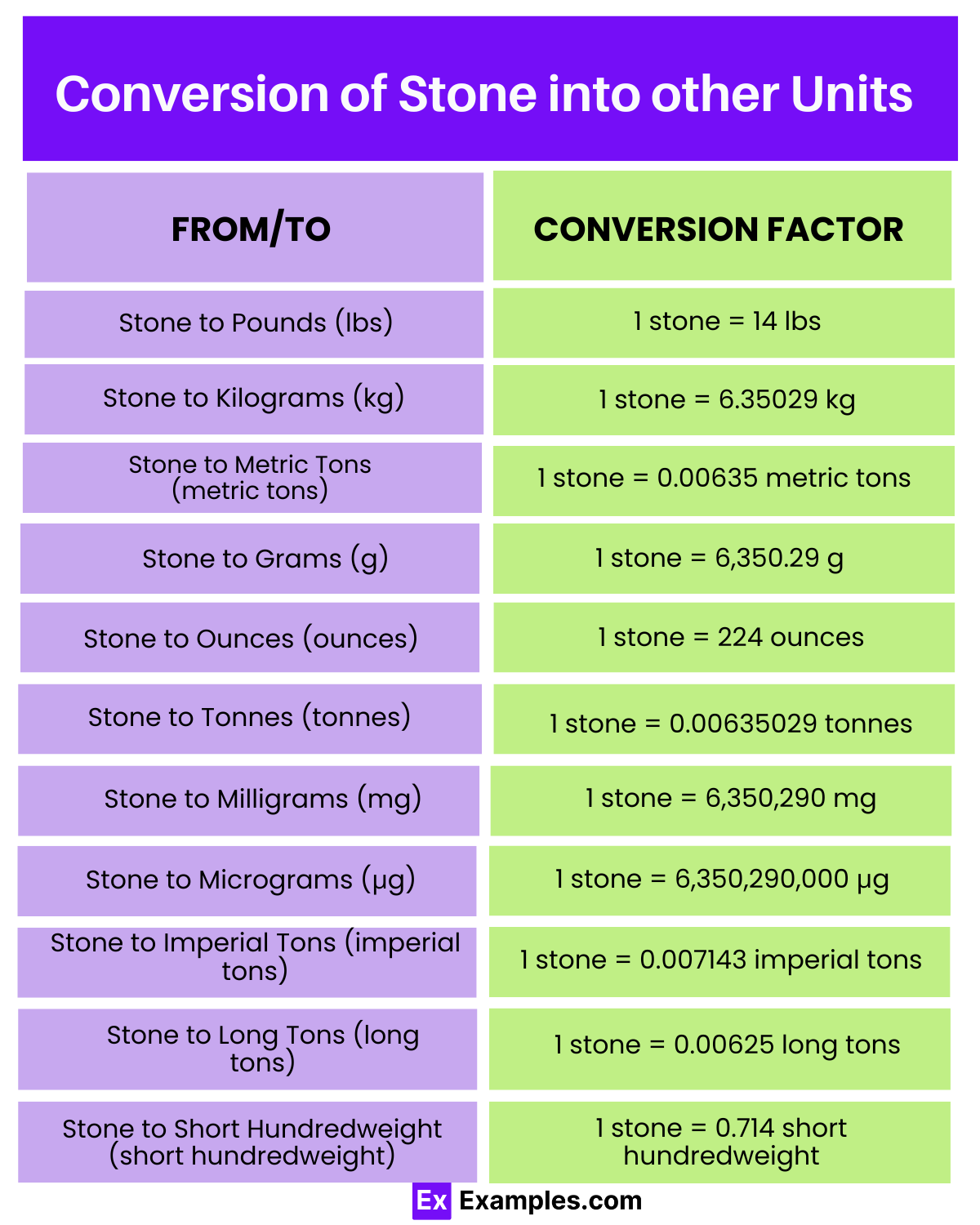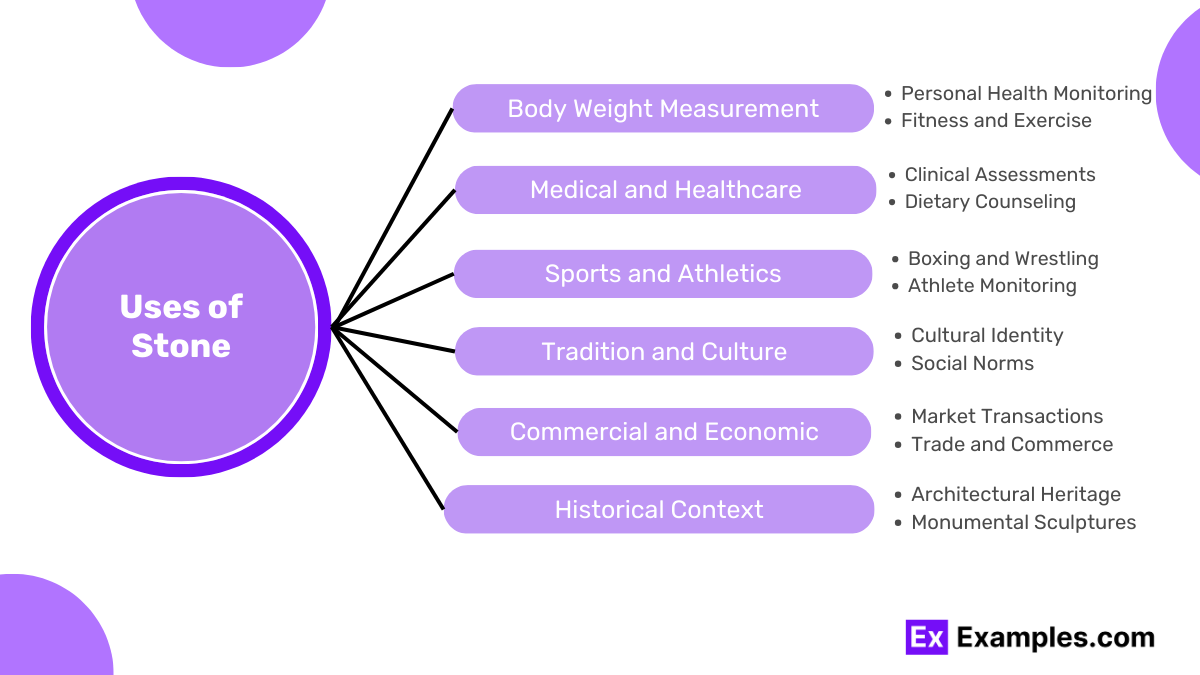What is the primary mineral component of granite?
Quartz
Calcite
Gypsum
Halite


Pounds = Stones × 14
| Prefix | Multiple | Symbol | Value |
|---|---|---|---|
| Kilo- | Kilostone | kst | 1 kst = 14,000 pounds |
| Mega- | Megastone | Mst | 1 Mst= 14,000,000 pounds |
| Giga- | Gigastone | Gst | 1 Gst = 14,000,000,000 pounds |
| Tera- | Terastone | Tst | 1 Tst = 14×1012 pounds |
| Peta- | Petastone | Pst | 1 Pst =14×1015 pounds |
| Exa- | Exastone | Est | 1 Est = 14×1018 pounds |
| Zetta- | Zettastone | Zst | 1 Zst = 14×1021 pounds |

| From/To | Conversion Factor | Example |
|---|---|---|
| Stone to Pounds (lbs) | 1 stone = 14 lbs | 10 stone = 140 lbs |
| Stone to Kilograms (kg) | 1 stone = 6.35029 kg | 10 stone = 63.5029 kg |
| Stone to Metric Tons (metric tons) | 1 stone = 0.00635 metric tons | 10 stone = 0.0635 metric tons |
| Stone to Grams (g) | 1 stone = 6,350.29 g | 10 stone = 63,502.9 g |
| Stone to Ounces (ounces) | 1 stone = 224 ounces | 10 stone = 2,240 ounces |
| Stone to Tonnes (tonnes) | 1 stone = 0.00635029 tonnes | 10 stone = 0.0635029 tonnes |
| Stone to Milligrams (mg) | 1 stone = 6,350,290 mg | 10 stone = 63,502,900 mg |
| Stone to Micrograms (μg) | 1 stone = 6,350,290,000 μg | 10 stone = 635,029,000,000 μg |
| Stone to Imperial Tons (imperial tons) | 1 stone = 0.007143 imperial tons | 10 stone = 0.07143 imperial tons |
| Stone to Long Tons (long tons) | 1 stone = 0.00625 long tons | 10 stone = 0.0625 long tons |
| Stone to Short Hundredweight (short hundredweight) | 1 stone = 0.714 short hundredweight | 10 stone = 7.14 short hundredweight |
One stone is equivalent to several pounds, making it a commonly used unit for measuring body weight in some countries
Stones are often converted to kilograms for use in scientific and medical contexts, providing a more precise measurement of mass.
While stones are a smaller unit of mass, they can be converted to metric tons for larger-scale measurements, especially in industries like agriculture and construction.
Stones can be broken down into grams for even finer measurements, commonly used in laboratory settings or when dealing with small quantities.
The conversion to ounces allows for a comparison to the traditional avoirdupois ounce, commonly used in the United States and other countries for both mass and volume measurements.
Despite its relatively small size, a stone can still be expressed in tonnes, which are commonly used in international trade and commerce.
For extremely precise measurements, stones can be converted to milligrams and even micrograms, important in fields like pharmaceuticals and nanotechnology.
For extremely precise measurements, stones can be converted to milligrams and even micrograms, important in fields like pharmaceuticals and nanotechnology.
In some contexts, particularly in the UK and Commonwealth countries, stones are converted to imperial tons or long tons for historical or traditional reasons.
In some contexts, particularly in the UK and Commonwealth countries, stones are converted to imperial tons or long tons for historical or traditional reasons.
The conversion to short hundredweight provides a comparison to the hundredweight unit commonly used in the United States for trade and commerce.
In the field of nutrition and dietetics, stone measurements are commonly used in the UK and Ireland to express body weight. For example, a person’s weight might be noted as “11 stone 6 pounds” instead of using kilograms or pounds alone. This traditional system provides a familiar and culturally relevant way to communicate weight, particularly in settings such as doctor’s offices, gyms, and weight loss clinics. It allows individuals to easily understand and track their weight progress in a manner that feels intuitive and comfortable.

A stone is a traditional unit of mass primarily used in the UK and Ireland, equivalent to 14 pounds or approximately 6.35 kilograms.
The stone has historical significance and cultural relevance in the UK and Ireland, providing a familiar and traditional way to express body weight.
While stone measurements provide a culturally relevant way to express weight, medical professionals may also use metric units for precise measurements in clinical settings.
Text prompt
Add Tone
10 Examples of Public speaking
20 Examples of Gas lighting
What is the primary mineral component of granite?
Quartz
Calcite
Gypsum
Halite
Which rock type is marble classified as?
Igneous
Sedimentary
Metamorphic
Volcanic
What is the main use of limestone in construction?
Roofing material
Concrete aggregate
Electrical insulation
Decorative flooring
Which stone is known as the hardest natural material?
Diamond
Corundum
Topaz
Quartz
What process leads to the formation of sedimentary rocks?
Cooling of magma
Compression and cementation of sediments
Metamorphism of existing rocks
Erosion and weathering
What mineral is the primary component of sandstone?
Feldspar
Quartz
Mica
Calcite
Which rock type is basalt classified as?
Igneous
Sedimentary
Metamorphic
Organic
Which natural stone is used primarily for kitchen countertops due to its durability and aesthetic appeal?
Slate
Limestone
Marble
Granite
What is the primary difference between igneous and sedimentary rocks?
Mineral composition
Formation process
Color
Hardness
Which rock is typically used for roofing tiles due to its ability to split into thin, flat sheets?
Granite
Marble
Slate
Basalt
Before you leave, take our quick quiz to enhance your learning!

